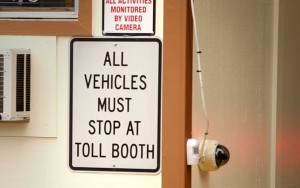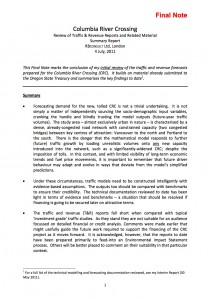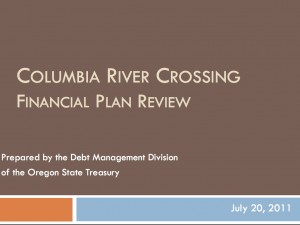Reports from two independent analysts looking at the Columbia River Crossing Light Rail project show grave reservations about the scope of the project and outdated data used to plan it.
In its July, 2011 report to the governors of Washington and Oregon, London-based RBConsult Ltd. writes that “In the absence of very strong arguments backed by empirical evidence, at this stage in the analysis the CRC traffic and revenue forecasts simply look too high.” Robert Bain, the principal of RBConsult, is a former Standard & Poor’s ratings analyst who has published widely on problems with the traffic and toll forecasting process.
Issues raised by the two analysts included information that was several years old, traffic patterns skewed by construction projects, and millions less in toll revenue than forecast.
Among the weaknesses Bain points out is that traffic and revenue reports “fall short when compared with typical ‘investment grade’ traffic studies,” and the traffic modeling activities described in the reports “are confusing and much of the work now appears to be dated.”
No mention is made in the reports of historical traffic patterns in the area or traffic volumes using the bridges, Bain writes, calling it “a strange omission.”
He adds that traffic volumes using the I-5 bridge have flattened off over the last 15 to 20 years, so “the key question is this: Is the flattening off symptomatic of the demand for travel across the river moderating, or is it simply that the bridge is operating for much of the day at or near capacity?”
According to the consultant, the Columbia River Crossing (CRC) data begs critical questions:- The numbers don’t reflect the impact of a dwindling job market and corresponding traffic drop. “Do we buy into the story that says tolling on the new crossing will suppress demand by only 16 percent?”
- And further, “Do we buy into the story that says that subsequent demand on the new tolled crossing will grow at rates commensurate with the highest rates of growth observed on the toll-free bridge over the past 25 years?”
- How many drivers will just abandon I-5 altogether and move to routes that don’t have tolls or construction, and what will the impact on those roads be? “The implications for traffic growth on I-205 are significant … Can the I-205 bridge really accommodate this projected level of diversion? If not, this suggests some weaknesses in the underlying traffic modeling that should be examined.”
Bain also points to an over-estimation of CRC demand, saying “no attempt has been made to adjust future demand in response to year-on-year tariff escalation.”
Traffic data skewed by road construction
A separate report, prepared by traffic engineering firm C&M Associates of Dallas, points out that during the process of the draft environmental impact statement the widening of I-5 in the Delta Park area was taking place, thus skewing the traffic data. “The construction project caused additional delays that may have resulted in a decrease of traffic volumes on I-5 with a diversion to I-205 … the data appears to indicate that the traffic loss on I-5 is a result of the Delta Park traffic congestion and the impact of the economic recession in the area. The DEIS (draft environmental impact statement) reports do not consider the impacts of the construction traffic.”
Herb Vargas and Carlos Contreras are principals at C&M and have international experience in investment grade studies. Their report adds that the Clark County area is “forecasted to have a larger increase in employment,” leading to higher reverse commuting patterns.
Both firms recommend that the CRC lower its baseline traffic and toll revenue forecasts, and recommend that annual gross toll revenue be assumed 15 percent to 25 percent lower than the forecast at the time the 2008 DEIS was adopted.
Oregon’s in-house financial review
Last April Oregon Gov. John Kitzhaber said that he and Washington Gov. Chris Gregore had “directed the treasurers of our two states to work with their own bond experts and if necessary with external specialists, to conduct an independent financial review of the CRC’s financial options …”
COUV.COM asked for that independent financial review and was provided with a review for the CRC that was prepared by the debt management division of the Oregon State Treasury in July, 2011.
In the Oregon State Treasury report, revenue from tolls is now estimated to be about $407 million less than originally thought.
Potential solutions “to the CRC funding gap” include federal Transportation Infrastructure Finance and Innovation Act (TIFIA) direct loans of $704 million to $833 million, the Oregon treasurer’s review says.
Conducting tolling on the bridge before the project is complete, and a primarily TIFIA loan funding approach “may be able to restore between $394 to $438 million in CRC funding*, while greatly reducing the financial risk to both states’ general funds and credit ratings.”
The review adds that failure to win federal funding for the transit portion of the project “may require rethinking of the overall project scope, timeline and financing plan.”
Coming Monday: A detailed look at the Oregon treasurer’s review of the CRC.
Listen to Kitzhaber’s comments about the financial report.
* The well-documented cost to taxpayers, if the CRC stays on budget, is $10 billion. This was established by the Cortright Report (PDF) which used data from an independent review panel hired by the governors of Washington and Oregon. (View the panel’s final report.)
See our continuing coverage of the Columbia River Crossing Light Rail project.
Do you have information to share on the CRC? To respond anonymously call 260-816-1426. To allow your comments to be used on COUV.COM call 260-816-1429.















[...] Clark County’s Online News Network informs us in Independent analyst: CRC revenue-from-toll forecasts ‘simply look too high’, “In its July, 2011 report to the governors of Washington and Oregon, London-based RBConsult Ltd. [...]